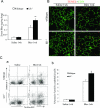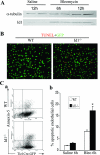Inhibitor of differentiation 1 promotes endothelial survival in a bleomycin model of lung injury in mice
- PMID: 17717145
- PMCID: PMC1988863
- DOI: 10.2353/ajpath.2007.070226
Inhibitor of differentiation 1 promotes endothelial survival in a bleomycin model of lung injury in mice
Abstract
The Id family of genes encodes negative regulators of basic helix-loop-helix transcription factors and has been implicated in diverse cellular processes such as proliferation, apoptosis, differentiation, and migration. However, the specific role of Id1 in lung injury has not been investigated. Bleomycin has been widely used to generate animal models of acute lung injury and fibrogenesis. In this study we found that, on bleomycin challenge, Id1 expression was significantly up-regulated in the lungs, predominantly in endothelial cells, as revealed by double immunolabeling and quantitative flow cytometric analysis. Mice with Id1 loss-of-function (Id1(-/-)) displayed increased vascular permeability and endothelial apoptosis in the lungs after bleomycin-induced injury. Cultured Id1(-/-) lung microvascular endothelial cells also showed decreased survival when exposed to bleomycin. We detected a decrease in the level of Bcl-2, a primary anti-apoptotic protein, in Id1(-/-) endothelial cells, suggesting that down-regulated Bcl-2 may promote endothelial apoptosis in the lung. Therefore, we propose that Id1 plays a crucial role in promoting endothelial survival in the adult lung on injury. In addition, bleomycin-exposed Id1(-/-) mice showed increased lung collagen accumulation and fibrogenesis, suggesting that Id1 up-regulation in the lung may play a critical role in lung homeostasis.
Figures








Similar articles
-
Cross talk between Id1 and its interactive protein Dril1 mediate fibroblast responses to transforming growth factor-beta in pulmonary fibrosis.Am J Pathol. 2008 Aug;173(2):337-46. doi: 10.2353/ajpath.2008.070915. Epub 2008 Jun 26. Am J Pathol. 2008. PMID: 18583319 Free PMC article.
-
Enhanced endogenous bone morphogenetic protein signaling protects against bleomycin induced pulmonary fibrosis.Respir Res. 2015 Mar 15;16(1):38. doi: 10.1186/s12931-015-0202-x. Respir Res. 2015. PMID: 25849157 Free PMC article.
-
Bleomycin-induced lung injury in mice investigated by MRI: model assessment for target analysis.Magn Reson Med. 2012 Feb;67(2):499-509. doi: 10.1002/mrm.23009. Epub 2011 Jun 7. Magn Reson Med. 2012. PMID: 21656559
-
Sphingolipids in pulmonary fibrosis.Adv Biol Regul. 2015 Jan;57:55-63. doi: 10.1016/j.jbior.2014.09.008. Epub 2014 Oct 13. Adv Biol Regul. 2015. PMID: 25446881 Free PMC article. Review.
-
Diabetic Microvascular Disease and Pulmonary Fibrosis: The Contribution of Platelets and Systemic Inflammation.Int J Mol Sci. 2016 Nov 8;17(11):1853. doi: 10.3390/ijms17111853. Int J Mol Sci. 2016. PMID: 27834824 Free PMC article. Review.
Cited by
-
Connective tissue growth factor acts within both endothelial cells and beta cells to promote proliferation of developing beta cells.Proc Natl Acad Sci U S A. 2011 Sep 13;108(37):15242-7. doi: 10.1073/pnas.1100072108. Epub 2011 Aug 29. Proc Natl Acad Sci U S A. 2011. PMID: 21876171 Free PMC article.
-
Direct leukocyte migration across pulmonary arterioles and venules into the perivascular interstitium of murine lungs during bleomycin injury and repair.Am J Pathol. 2011 Jun;178(6):2560-72. doi: 10.1016/j.ajpath.2011.02.047. Am J Pathol. 2011. PMID: 21641381 Free PMC article.
-
Cross talk between Id1 and its interactive protein Dril1 mediate fibroblast responses to transforming growth factor-beta in pulmonary fibrosis.Am J Pathol. 2008 Aug;173(2):337-46. doi: 10.2353/ajpath.2008.070915. Epub 2008 Jun 26. Am J Pathol. 2008. PMID: 18583319 Free PMC article.
-
Id proteins regulate capillary repair and perivascular cell proliferation following ischemia-reperfusion injury.PLoS One. 2014 Feb 7;9(2):e88417. doi: 10.1371/journal.pone.0088417. eCollection 2014. PLoS One. 2014. PMID: 24516656 Free PMC article.
-
Foxc transcription factors directly regulate Dll4 and Hey2 expression by interacting with the VEGF-Notch signaling pathways in endothelial cells.PLoS One. 2008 Jun 11;3(6):e2401. doi: 10.1371/journal.pone.0002401. PLoS One. 2008. PMID: 18545664 Free PMC article.
References
-
- Ruzinova MB, Benezra R. Id proteins in development, cell cycle and cancer. Trends Cell Biol. 2003;13:410–418. - PubMed
-
- Zebedee Z, Hara E. Id proteins in cell cycle control and cellular senescence. Oncogene. 2001;20:8317–8325. - PubMed
-
- Benezra R, Rafii S, Lyden D. The Id proteins and angiogenesis. Oncogene. 2001;20:8334–8341. - PubMed
-
- Wong YC, Wang X, Ling MT. Id-1 expression and cell survival. Apoptosis. 2004;9:279–289. - PubMed
Publication types
MeSH terms
Substances
Grants and funding
LinkOut - more resources
Full Text Sources
Medical
Molecular Biology Databases

